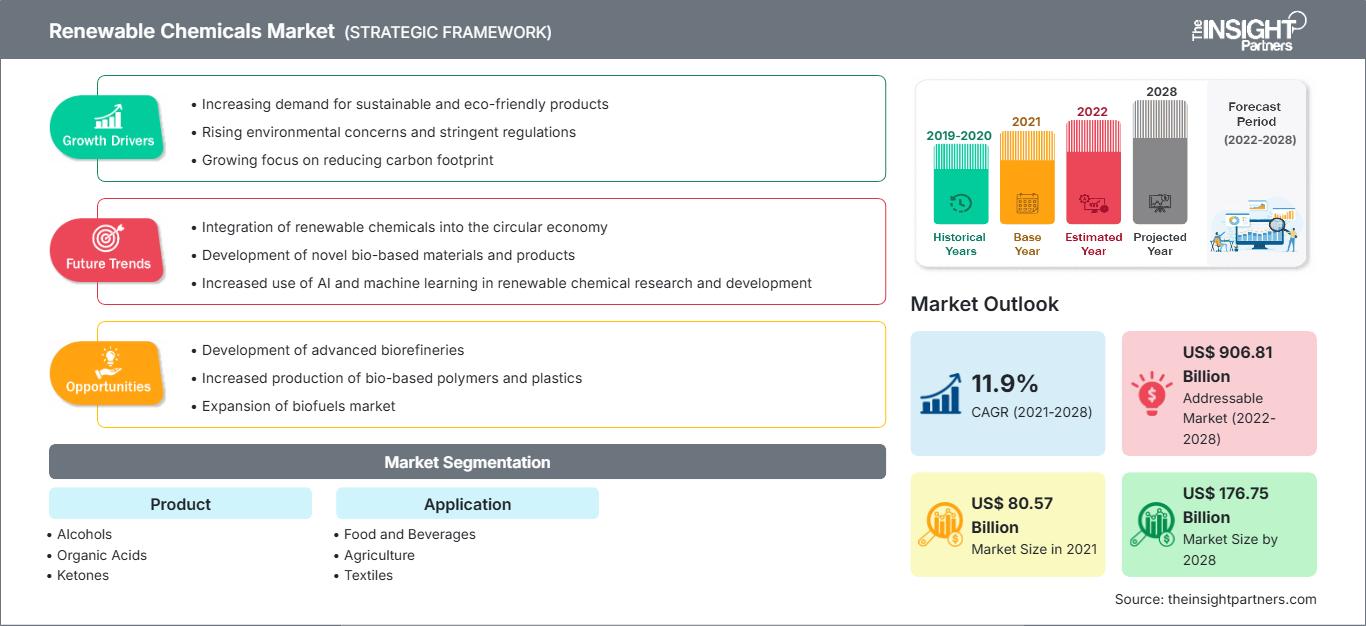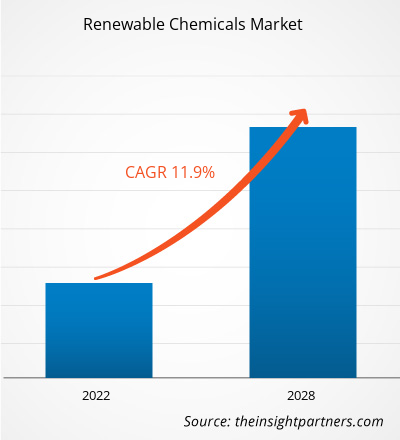El mercado de productos químicos renovables se valoró en US$ 80.566,30 millones en 2021 y se espera que crezca a una CAGR del 11,9% entre 2021 y 2028.
Los productos químicos renovables o de origen biológico se definen como aquellas categorías de productos químicos sintetizados a partir de fuentes renovables, como materias primas agrícolas, residuos agrícolas, residuos orgánicos, biomasa y microorganismos. Se clasifican como productos químicos sostenibles y respetuosos con el medio ambiente que generan una menor huella de carbono que los productos químicos tradicionales derivados del petróleo. Algunos de los productos químicos renovables más disponibles son la lignina, los carbohidratos, los aceites, los extractos vegetales, la hemicelulosa, la celulosa, el almidón, las proteínas, entre otros. Estos productos químicos se utilizan en diversas aplicaciones, como la alimentación y las bebidas, la agricultura, los textiles, la automoción y el embalaje, entre otras.
En 2021, América del Norte contribuyó con la mayor participación en el mercado mundial de productos químicos renovables. El predominio de este mercado en esta región se debe principalmente a la sólida base industrial, con importantes fabricantes que contribuyen significativamente al crecimiento del mercado. La alta demanda de productos químicos renovables en aplicaciones como alimentos y bebidas, agricultura, textiles, transporte, embalaje y otras industrias, respaldada por un crecimiento significativo en las bases industriales de uso final, está impulsando la demanda de productos químicos renovables en el mercado regional. El aumento de la inversión en el sector manufacturero, junto con la creciente atención a las soluciones ecológicas y sostenibles, ofrece oportunidades lucrativas para el crecimiento del mercado de productos químicos renovables en América del Norte. Además, se espera que las políticas favorables para promover el uso de productos químicos de origen biológico y renovables en lugar de los productos químicos convencionales derivados del petróleo generen oportunidades de crecimiento lucrativas en la región.
Personalice este informe según sus necesidades
Obtendrá personalización en cualquier informe, sin carga, incluidas partes de este informe o análisis a nivel de país, paquete de datos de Excel, así como también grandes ofertas y descuentos para empresas emergentes y universidades.
Mercado de productos químicos renovables: perspectivas estratégicas

-
Obtenga las principales tendencias clave del mercado de este informe.Esta muestra GRATUITA incluye análisis de datos, desde tendencias del mercado hasta estimaciones y pronósticos.
Impacto de la pandemia de COVID-19 en el mercado de productos químicos renovables
La pandemia actual ha alterado drásticamente la situación del sector industrial y ha afectado negativamente al crecimiento del mercado de productos químicos renovables. La implementación de medidas para combatir la propagación del virus ha agravado la situación y ha afectado al crecimiento de varios sectores industriales. Industrias como la alimentación y bebidas, la agricultura, los textiles, el transporte, el embalaje y la farmacéutica se han visto afectadas por la repentina distorsión de la eficiencia operativa y las interrupciones en las cadenas de valor atribuibles al cierre repentino de las fronteras nacionales e internacionales. La significativa disminución del crecimiento de varios sectores industriales afectó negativamente a la demanda de productos químicos renovables en el mercado global. Las interrupciones en el abastecimiento de materias primas de los proveedores, así como los cierres temporales de las plantas de fabricación debido a confinamientos indefinidos y cuarentenas temporales, han afectado al crecimiento del mercado durante el período de la pandemia. Sin embargo, a medida que las economías planean reactivar sus operaciones, se espera que la demanda de productos químicos renovables aumente a nivel mundial. Si bien el enfoque en la producción justo a tiempo es otro factor preocupante que obstaculiza el crecimiento del mercado. Se espera que la creciente demanda de productos químicos renovables en los sectores de alimentos y bebidas, agricultura, textiles, transporte, embalaje, productos farmacéuticos y otras industrias, junto con una importante inversión por parte de fabricantes destacados, impulse el crecimiento de los productos químicos renovables.
Perspectivas del mercado
La creciente conciencia sobre los productos químicos renovables se ve respaldada por las crecientes preocupaciones ambientales
Las ciencias renovables se han considerado una de las formas efectivas de promover la calidad del aire, el agua y el suelo, y contribuir a la sostenibilidad mediante la comercialización del uso de productos químicos de base biológica ecológicos en diversas aplicaciones. Los productos químicos renovables sostenibles y ecológicos pueden obtenerse de materias primas renovables como biomasa, residuos agrícolas o materias primas y microorganismos con la ayuda de la síntesis de química verde o biorrefinerías. Los gobiernos de varias economías han implementado regulaciones estrictas relacionadas con las emisiones de carbono y gases de efecto invernadero para promover un medio ambiente de alta calidad. Por ejemplo, la Comisión Europea tiene como objetivo lograr una reducción del 80% en las emisiones de carbono para 2050 mediante la eliminación gradual de ~ 81Mt de dióxido de carbono que se utilizarán en la producción de clínker. Los organismos reguladores, como REACH (Registro, Evaluación, Autorización y Restricción de Sustancias Químicas), EPA (Agencia de Protección Ambiental) y la Comisión Europea imponen estrictas regulaciones ambientales sobre la producción y eliminación de productos petroquímicos. Además, el creciente enfoque de la Unión Europea en el establecimiento de una "Economía Verde", junto con su iniciativa "20-20-20", está reduciendo progresivamente la demanda de petroquímicos. La reducción de los recursos petroleros, junto con la inestabilidad política en los principales países productores y la volatilidad de sus precios, incrementa la preferencia por los productos químicos renovables. El calentamiento global y el cambio climático están generando una demanda de productos saludables, ecológicos y limpios. Además, la economía circular está generando nuevas oportunidades por valor de más de 5,6 billones de dólares estadounidenses para el desarrollo de tecnologías ecológicas, incluyendo la tecnología asociada a los productos químicos renovables. Estos esfuerzos de colaboración, regulaciones e iniciativas impulsan el crecimiento del mercado de los productos químicos renovables.
Información sobre el producto
Según el producto, el mercado de productos químicos renovables se clasifica en alcoholes, ácidos orgánicos, cetonas, productos químicos de plataforma, biopolímeros y otros. Se espera que el segmento de biopolímeros sea el de mayor crecimiento en el mercado global de productos químicos renovables durante el período de pronóstico. Se proyecta que la creciente demanda de materiales de embalaje ecológicos, junto con el creciente uso de biopolímeros en la industria automotriz, impulse el crecimiento de los biopolímeros en el mercado de productos químicos renovables. Los biopolímeros incluyen polinucleótidos (ADN, ARN), celulosa, quitosano, quitina, almidón, proteínas, poliésteres, pectina, colágeno, gelatina y gluten, entre otros. Representan una alternativa innovadora y prometedora para reducir las emisiones de gases de efecto invernadero y tóxicas, y el uso de recursos no renovables. Se espera que el creciente enfoque hacia materiales respetuosos con el medio ambiente y sostenibles impulse la demanda de biopolímeros.
Perspectivas de la aplicación
Según su aplicación, el mercado de productos químicos renovables se clasifica en alimentos y bebidas, agricultura, textiles, transporte, productos químicos intermedios, embalajes, productos biomédicos y farmacéuticos, entre otros. En 2021, el segmento de transporte domina el mercado de productos químicos renovables. La biomasa, las astillas de madera, los residuos de cultivos, etc., se convierten en combustibles renovables para el transporte. Diversos tipos de alcoholes de origen biológico, como el biobutanol, el bioetanol y el biometanol, se utilizan como combustible en aviones a reacción. El bioetanol es la fuente de energía más utilizada para el transporte. Se prevé que el uso de bioetanol aumente significativamente en los próximos años y se mantenga en niveles altos. Este cambio hacia un mayor uso de bioetanol brindará más oportunidades en el futuro. El metano es otro producto químico renovable utilizado como combustible para el transporte y es el principal componente del gas natural comprimido. Se produce a partir de biomasa mediante un proceso bioquímico llamado digestión anaeróbica. El biodiésel es un sustituto renovable del combustible diésel que se produce mezclando cualquier aceite o grasa natural con un alcohol (generalmente metanol). Diferentes aceites vegetales, grasas animales y grasas de cocina recicladas también pueden transformarse en biodiesel.
Algunos de los principales actores clave que operan en el mercado de productos químicos renovables son BASF SE; Amyris Inc; DSM; Archer-Daniels-Midland Company (ADM); y The Dow Chemical Company. Estos actores del mercado se centran principalmente en el desarrollo de productos innovadores y de alta calidad.
Perspectivas regionales del mercado de productos químicos renovables
Los analistas de The Insight Partners han explicado detalladamente las tendencias regionales y los factores que influyen en el mercado de productos químicos renovables durante el período de pronóstico. Esta sección también analiza los segmentos y la geografía del mercado de productos químicos renovables en América del Norte, Europa, Asia Pacífico, Oriente Medio y África, y América del Sur y Central.
Alcance del informe del mercado de productos químicos renovables
| Atributo del informe | Detalles |
|---|---|
| Tamaño del mercado en 2021 | US$ 80.57 mil millones |
| Tamaño del mercado en 2028 | US$ 176.75 mil millones |
| CAGR global (2021-2028) | 11,9% |
| Datos históricos | 2019-2020 |
| Período de pronóstico | 2022-2028 |
| Segmentos cubiertos |
Por producto
|
| Regiones y países cubiertos |
América del norte
|
| Líderes del mercado y perfiles de empresas clave |
|
Densidad de actores del mercado de productos químicos renovables: comprensión de su impacto en la dinámica empresarial
El mercado de productos químicos renovables está creciendo rápidamente, impulsado por la creciente demanda del usuario final debido a factores como la evolución de las preferencias de los consumidores, los avances tecnológicos y un mayor conocimiento de los beneficios del producto. A medida que aumenta la demanda, las empresas amplían su oferta, innovan para satisfacer las necesidades de los consumidores y aprovechan las tendencias emergentes, lo que impulsa aún más el crecimiento del mercado.

- Obtenga una descripción general de los principales actores clave del mercado de productos químicos renovables.
Informe destacado
- Tendencias progresivas de la industria en el mercado de productos químicos renovables para ayudar a los actores a desarrollar estrategias efectivas a largo plazo.
- Estrategias de crecimiento empresarial adoptadas por los mercados desarrollados y en desarrollo
- Análisis cuantitativo del mercado de productos químicos renovables de 2019 a 2028
- Estimación de la demanda mundial de productos químicos renovables
- Análisis PEST para ilustrar la eficacia de los compradores y proveedores que operan en la industria.
- Desarrollos recientes para comprender el escenario del mercado competitivo
- Tendencias y perspectivas del mercado, así como factores que impulsan y restringen el crecimiento del mercado de productos químicos renovables.
- Asistencia en el proceso de toma de decisiones destacando las estrategias de mercado que sustentan el interés comercial, lo que conduce al crecimiento del mercado.
- Descripción detallada y segmentación del mercado, así como la dinámica de la industria de productos químicos renovables.
- Tamaño del mercado de productos químicos renovables en diversas regiones con prometedoras oportunidades de crecimiento
Mercado de productos químicos renovables, por producto
- Alcoholes
- Ácidos orgánicos
- Cetonas
- Productos químicos de plataforma
- Biopolímeros
- Otros
Mercado de productos químicos renovables, por aplicación.
- Alimentos y bebidas
- Agricultura
- Textiles
- Transporte
- Intermedios químicos
- Embalaje
- Biomédica y farmacéutica
- Otros
Perfiles de empresas
- Compañía Archer-Daniels-Midland (ADM)
- Cargill Inc
- DSM
- BASF SE
- Amyris Inc
- Evonik Industries AG
- Solvay
- La compañía química Dow
- Genomatica, Inc
- Braskem
- Análisis histórico (2 años), año base, pronóstico (7 años) con CAGR
- Análisis PEST y FODA
- Tamaño del mercado, valor/volumen: global, regional y nacional
- Industria y panorama competitivo
- Conjunto de datos de Excel
Informes recientes
Informes relacionados
Testimonios
Razón para comprar
- Toma de decisiones informada
- Comprensión de la dinámica del mercado
- Análisis competitivo
- Información sobre clientes
- Pronósticos del mercado
- Mitigación de riesgos
- Planificación estratégica
- Justificación de la inversión
- Identificación de mercados emergentes
- Mejora de las estrategias de marketing
- Impulso de la eficiencia operativa
- Alineación con las tendencias regulatorias






















 Obtenga una muestra gratuita para - Mercado de productos químicos renovables
Obtenga una muestra gratuita para - Mercado de productos químicos renovables